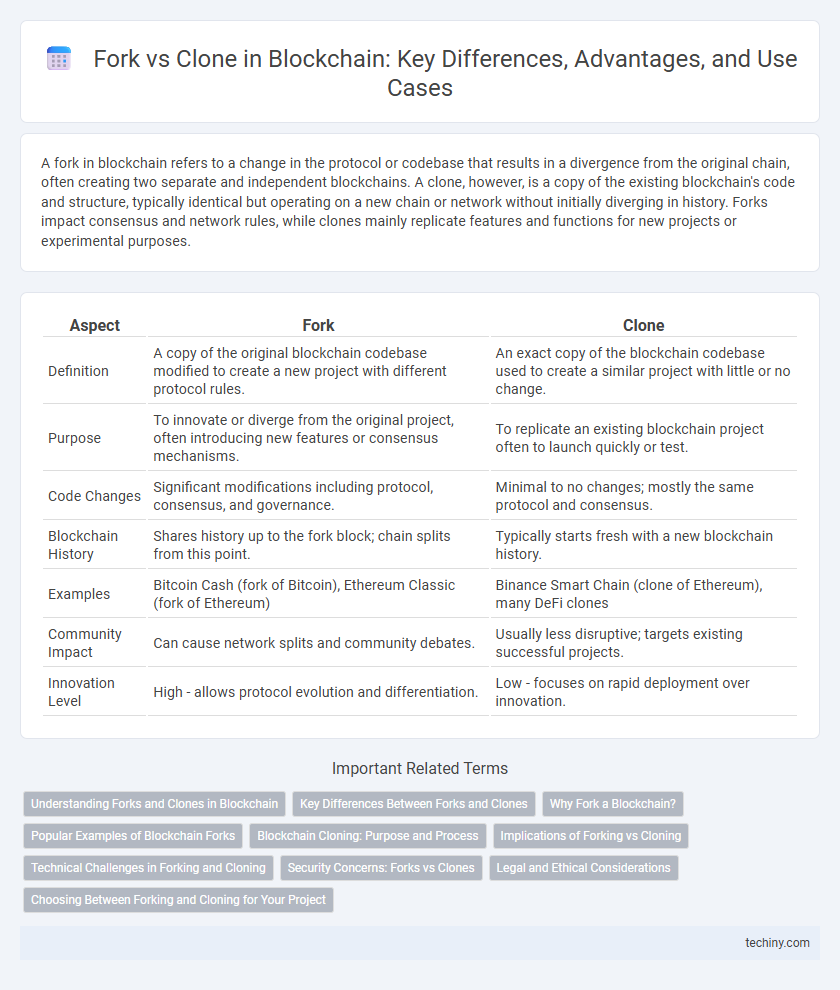A fork in blockchain refers to a change in the protocol or codebase that results in a divergence from the original chain, often creating two separate and independent blockchains. A clone, however, is a copy of the existing blockchain's code and structure, typically identical but operating on a new chain or network without initially diverging in history. Forks impact consensus and network rules, while clones mainly replicate features and functions for new projects or experimental purposes.
Table of Comparison
| Aspect | Fork | Clone |
|---|---|---|
| Definition | A copy of the original blockchain codebase modified to create a new project with different protocol rules. | An exact copy of the blockchain codebase used to create a similar project with little or no change. |
| Purpose | To innovate or diverge from the original project, often introducing new features or consensus mechanisms. | To replicate an existing blockchain project often to launch quickly or test. |
| Code Changes | Significant modifications including protocol, consensus, and governance. | Minimal to no changes; mostly the same protocol and consensus. |
| Blockchain History | Shares history up to the fork block; chain splits from this point. | Typically starts fresh with a new blockchain history. |
| Examples | Bitcoin Cash (fork of Bitcoin), Ethereum Classic (fork of Ethereum) | Binance Smart Chain (clone of Ethereum), many DeFi clones |
| Community Impact | Can cause network splits and community debates. | Usually less disruptive; targets existing successful projects. |
| Innovation Level | High - allows protocol evolution and differentiation. | Low - focuses on rapid deployment over innovation. |
Understanding Forks and Clones in Blockchain
Forks in blockchain refer to protocol updates that create a divergence in the chain, resulting in a permanent or temporary split; hard forks lead to incompatible chains, while soft forks maintain backward compatibility. Clones involve copying an existing blockchain's codebase to create a new, independent chain without inheriting its history or consensus. Understanding these concepts is crucial for developers and users to navigate governance, security, and innovation in blockchain ecosystems.
Key Differences Between Forks and Clones
Forks and clones both involve copying blockchain code but differ significantly in purpose and implementation. A fork modifies the existing blockchain protocol, creating a divergent chain with altered rules, while a clone replicates the original blockchain's codebase to launch a new, independent project without altering the original protocol. Forks maintain transaction history continuity and network consensus, whereas clones start fresh with their own genesis block and community.
Why Fork a Blockchain?
Forking a blockchain enables developers to create a distinct version of the original ledger, allowing protocol upgrades, bug fixes, or new features without affecting the main chain's history. This process ensures network consensus adaptability while maintaining immutability and transparency, essential for decentralization. Forks can be soft, preserving backward compatibility, or hard, leading to permanent splits and new cryptocurrencies.
Popular Examples of Blockchain Forks
Popular examples of blockchain forks include Bitcoin Cash, created as a hard fork from Bitcoin to increase transaction speed and reduce fees, and Ethereum Classic, which resulted from a split in the Ethereum network following the DAO hack. Soft forks like Segregated Witness (SegWit) on Bitcoin brought backward-compatible upgrades without splitting the chain. These forks demonstrate how blockchain communities adapt to scalability, security, or ideological differences while maintaining network integrity or diverging into new projects.
Blockchain Cloning: Purpose and Process
Blockchain cloning involves copying an existing blockchain's entire ledger and codebase to create a duplicate network, primarily for testing or development purposes without affecting the original chain. Unlike a fork, which modifies the blockchain's protocol to create a divergent path and potentially a new cryptocurrency, cloning maintains the original consensus rules and data intact. This process enables developers to experiment in an isolated environment, ensuring innovations or upgrades can be validated before deployment on the live blockchain.
Implications of Forking vs Cloning
Forking a blockchain creates a distinct, independent chain with its own transaction history and governance, potentially leading to network splits and community division. Cloning replicates the blockchain's codebase without inheriting its transaction history, enabling customization without compatibility issues. The choice between forking and cloning impacts decentralization, security, and the level of innovation possible within the new project.
Technical Challenges in Forking and Cloning
Forking a blockchain involves creating a divergent path from the original chain, presenting technical challenges such as ensuring consensus mechanism compatibility and managing state synchronization without causing network splits. Cloning a blockchain requires duplicating the entire codebase and network parameters, demanding precise replication of protocol rules and seamless integration of peer-to-peer communication to maintain network stability. Both processes must address security vulnerabilities, data integrity, and cross-chain transaction issues to maintain decentralized trust and functionality.
Security Concerns: Forks vs Clones
Forks in blockchain create divergent chains that maintain the original network's security infrastructure and consensus mechanisms, minimizing vulnerabilities. Clones replicate the codebase but operate independently, often lacking the original community support and security audits, increasing risks of exploits. Consequently, forks benefit from inherited security protocols, while clones require extensive safeguards to mitigate potential threats.
Legal and Ethical Considerations
Forks in blockchain projects often raise complex legal issues related to intellectual property rights and licensing agreements, as they involve modifying and redistributing existing codebases under open-source licenses. Clones, while structurally similar, can lead to ethical concerns around originality and copying without appropriate attribution, potentially infringing on trademark protections or community trust. Both forks and clones require careful adherence to legal frameworks and ethical standards to maintain transparency and respect for the original developers' contributions.
Choosing Between Forking and Cloning for Your Project
Choosing between forking and cloning a blockchain project depends on your goals and technical requirements. Forking creates a new independent blockchain with its own consensus rules, suitable for implementing significant changes or launching a unique cryptocurrency. Cloning replicates the existing codebase without altering the original project's trajectory, ideal for testing, development, or deploying similar applications quickly.
Fork vs Clone Infographic

 techiny.com
techiny.com